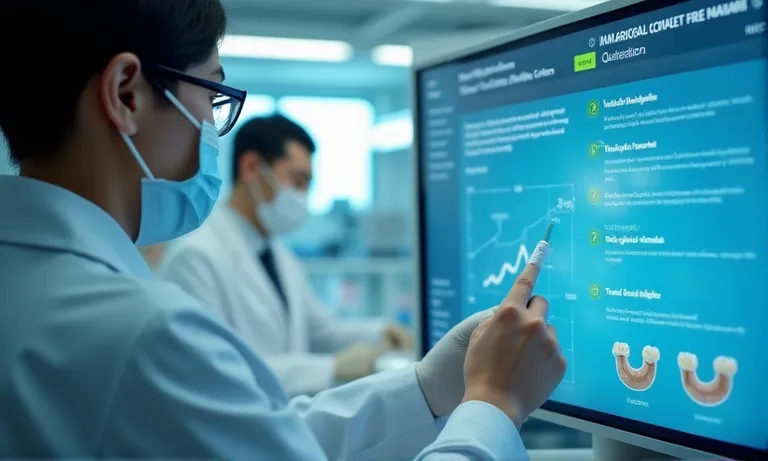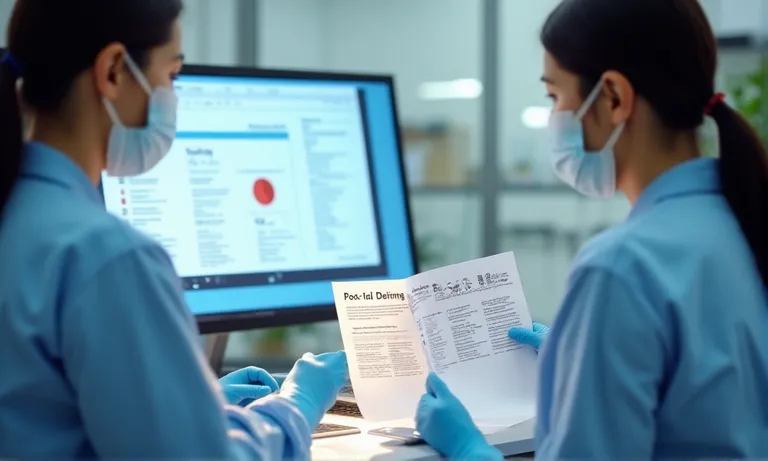Trial orders are no longer optional—they are a proven method for procurement teams to validate whether a dental lab’s digital workflow is truly ready for real-world collaboration. More revealing than spec sheets or promises, a trial exposes how a lab performs under live conditions: file compatibility, process transparency, communication rhythm, and timeline adherence.
To accurately assess digital readiness through a trial order, focus on five key checkpoints:
- Preparation Before Trial: Align on scanner formats, portal credentials, and file submission protocols.
- In-Process Monitoring: Observe file uploads, version control, timestamped updates, and feedback response times.
- Post-Trial Evaluation: Review performance against expected turnaround, communication clarity, and case outcome.
- Readiness Indicators: Look for structured revision tracking, SLA coverage, and system-driven workflows.
- Decision Alignment: Use trial findings to guide vendor approval, process adjustments, or contract scaling.
Trial orders are not about testing one crown—they’re about testing the lab’s ability to operate as a reliable node in your digital ecosystem.
Why Are Trial Orders Essential for Verifying Digital Workflow Compatibility?
A lab may present polished marketing decks, impressive equipment lists, and slick dashboards—but none of these guarantee digital readiness in a live production environment. Trial orders reveal what spec sheets cannot: how systems, files, and people interact when timing, accuracy, and traceability are on the line.
For dental procurement teams, trial cases serve as low-risk, high-yield experiments to test the real-world compatibility between clinic protocols and lab execution flow.

digital-trial-order-verification-in-dental-lab
What typical digital errors are only revealed through real-world test cases?
Even labs with certified software may fail in these areas:
- Incorrect STL interpretation due to scanner calibration mismatches
- Missed design intent when technicians overlook special notes or digital forms
- File version confusion when multiple uploads are not properly version-controlled
- Feedback delays from unclear internal routing or single-point bottlenecks
These cannot be observed through slide decks or brochures—they only show up when timelines and files are moving.
Why a hands-on trial is more reliable than technical spec sheets?
Spec sheets list theoretical compatibility. Trial orders show functional compatibility.
- They validate scanner-to-lab handoff for your exact equipment and settings
- They test how labs interpret your digital Rx, case photos, or scan flags
- They expose where miscommunication might cause remake risks or delay traps
Digital specs ≠ digital execution. Procurement needs proof, not promises.
How trial orders reveal weaknesses in file handling and communication flow?
A single crown trial can surface issues like:
- Unlogged status changes or invisible file approvals
- Communication roundtrips that exceed 24–48 hours
- Inability to escalate urgent revisions or add attachments post-submission
- Lack of notifications on lab-side modifications
These issues may not stop one case—but they will scale poorly.
✅ Trial orders reveal operational truths that no lab brochure can simulate – TRUE
They stress-test system responsiveness, traceability, and human interpretation under real-world pressure.
❌ Assuming digital readiness based on software lists alone – FALSE
Many labs may list “digital workflow” as a capability, but fail to execute consistently without a validated test run.
What Should Be Prepared Before Launching a Trial Order?
A successful trial order begins long before the first scan is uploaded. Without proper setup, even the most advanced digital lab can fail—not due to incompetence, but due to misaligned formats, missing inputs, or unclear expectations.
Buyers should approach trial orders as controlled pilots: every variable counts. Clarity at this stage helps ensure that any issues observed are performance-related, not setup errors.

dental-lab-trial-order-preparation-checklist
Are scanner formats and STL files fully compatible?
Every lab accepts STL files—but not every STL file is created equally.
- Confirm whether your scanner exports files in lab-acceptable resolution
- If using intraoral scanners like iTero or TRIOS, check whether open/export licenses are needed
- Some labs provide sample test STL files to pre-check alignment before submission
Clarify scanner compatibility in advance helps avoid technical stalls. Learn more about intraoral scanner compatibility across popular lab platforms.Checking this prevents workflow stalls on day one.
Does the lab provide onboarding, protocols, or format guidelines?
Labs that welcome trials should offer basic onboarding support:
- File naming conventions (e.g., case ID, patient initials, arch type)
- Rx form templates or digital prescription guidelines
- Optional walkthroughs on how to navigate the portal and upload steps
Well-defined intake protocols minimize the chance of user-side error.
Is there a test account or demo access for portal functions?
Trialing a case means trialing the system too.
- Ask for a temporary login to preview portal navigation
- Upload a dummy file or draft case to check whether logs, comments, and file status updates function properly
- Confirm whether you’ll be notified of status changes and technician messages
This “sandbox” approach allows validation without affecting live case flow.
Trial Order Preparation Summary Checklist
- ✅ Match scanner export format with lab requirements
- ✅ Obtain and follow digital Rx and intake protocols
- ✅ Test portal login, upload, and file tracking features
- ✅ Pre-align naming conventions and approval routes
- ✅ Confirm lab contact channel and time-zone expectations
Setting up properly ensures trial results reflect the lab’s true performance—not miscommunication noise.
What Digital Workflow Checkpoints Should Be Monitored During the Trial?
A trial order is more than a delivery test—it’s a diagnostic window into how a lab runs its digital engine. From the first file upload to the final delivery confirmation, every step offers insight into traceability, communication flow, and accountability.
Rather than simply checking if the crown fits, procurement teams should monitor how the process fits.

dental-lab-digital-checkpoints-trial-monitoring
Is each status update logged, timestamped, and reviewable?
Process transparency is fundamental.
- Can you see exactly when each milestone occurs—like design upload, approval, production, and dispatch?
- Are status changes timestamped and attributed to a lab user?
- Do you receive email or in-platform alerts when actions are completed?
If the case moves forward but the system doesn’t reflect it, you’re operating in the dark.
Are design previews or revision requests handled systematically?
This step reveals how the lab interprets input—and how flexible they are in feedback.
- Can you preview designs (e.g., crown anatomy, contact zones, margin visibility) before approval?
- Are modification requests clearly logged, not just exchanged via email?
- Is there a visual annotation tool within the platform?
A visual review process avoids the back-and-forth ambiguity that slows digital workflows.
How long does each communication round take, and is it traceable?
One of the key hidden costs is time lost in waiting for replies.
- Measure response latency from when a comment is submitted to when it’s addressed
- Is there a log showing when each message was read or responded to?
- Can delays be escalated or flagged internally?
Long turnaround loops in trial cases often predict workflow stress under full production.
Digital Workflow Monitoring Checklist
- ✅ All status updates are timestamped and visible on the dashboard
- ✅ Design previews are reviewable with clear feedback tools
- ✅ Revision requests are logged and visually annotated
- ✅ Communication loops are traceable, with response time benchmarks
- ✅ Alerts and escalations are supported for slow-moving cases
Labs that score high on these checkpoints show not just technical ability—but operational maturity.
How to Evaluate the Trial Order After Completion?
Finishing the trial isn’t the finish line—it’s the moment of clarity. At this stage, procurement teams need to shift from case-level assessment (“Did the crown fit?”) to system-level reflection (“Did the workflow function?”). A single case won’t predict every future issue, but it can expose patterns that scale—good or bad.
The goal is not perfection, but signal: is this lab’s digital operation structured, responsive, and reliable enough to handle repeat volume?

evaluating-dental-lab-trial-order-performance
Was the digital workflow smooth from upload to delivery?
Look at the flow as a chain:
- Were you able to upload files and instructions without friction?
- Was the case acknowledged and moved into production quickly?
- Were there any unexplained silences or manual email follow-ups needed?
A seamless experience reflects digital maturity—not just isolated efficiency.
Did the lab meet your expected turnaround and feedback timelines?
Time benchmarks are the most tangible KPI.
- Did approvals and revisions happen within the window you agreed upon?
- Were SLAs mentioned, tracked, and reflected in your dashboard?
- Did feedback loops close within 1 business day, or get stuck in limbo?
Labs that can’t keep pace in a trial will likely underperform at scale.
You can benchmark performance against published digital workflow SLA standards from Dental Products Report for reference.
Were any issues in format, approval, or final delivery reported?
Issues are not deal-breakers—how they’re resolved often matters more.
- Did the lab flag and fix file issues proactively?
- Were design mismatches handled with clarity and logged revisions?
- Was the final delivery traceable, approved, and documented?
If the trial ends with gaps in communication or missing logs, those are risk indicators.
Trial Evaluation Checklist
- ✅ Workflow was consistent from upload to final dispatch
- ✅ Feedback and approvals met your timing expectations
- ✅ Any issues were handled with clarity and escalation path
- ✅ Platform logs reflected case status at all times
- ✅ Delivery was on-time, with no manual workarounds needed
Post-trial evaluation gives your team the operational data to decide whether the lab is a match—not just for one case, but for your system.
What Indicators Signal True Digital Workflow Readiness?
Not all labs that “accept digital files” are digitally ready. True digital workflow readiness is reflected in structure, consistency, and traceability—not just in the ability to open an STL file.
As procurement teams evaluate labs post-trial, they should look beyond basic file exchange and focus on whether the lab operates through a system, not improvisation.

signs-of-digital-readiness-in-dental-labs
Consistent portal use and case traceability
Can every case be traced from upload to delivery through a single interface?
- Look for logs that show case status, user actions, time stamps
- Confirm that no steps rely on email attachments or verbal updates
- Evaluate how accessible the case history is for audit or repeat cases
On-time delivery aligned with digital checkpoints
Delivery is just the output—the checkpoints are what make it reliable.
- Is the lab logging when files are received, processed, and approved?
- Are there alerts or escalations for delays or revision loops?
- Can you compare case cycle time against your original Rx time window?
If timelines vary without explanation, systems may be reactive, not ready.
File safety, version control, and structured revision management
Real labs lose files too—but ready labs know exactly when and why.
- Are there clear file version labels tied to timestamps and user IDs?
- Is feedback preserved and visible across revision rounds?
- Does the system log approvals with click-to-confirm steps?
If case edits happen silently, it’s a signal of workflow immaturity.
✅ Digital workflow readiness is visible in system structure, not just capability – TRUE
What matters is not whether they can accept STL files, but how they manage, track, and escalate them reliably across cases.
❌ Any lab that “accepts digital files” is digitally ready – FALSE
Receiving files doesn’t mean running a digital workflow. True readiness shows up in consistency, visibility, and accountability—not just compatibility.
How to Ask the Right Questions After the Trial?
Completing a trial order gives you more than a result—it gives you leverage. What happens next often determines whether the relationship moves forward. The most effective procurement teams use this phase to ask smart, non-confrontational questions that signal expectations and invite transparency.
Think of it as a checkpoint, not a verdict.

post-trial-dental-lab-question-session
What did the lab learn or improve from your trial experience?
Great labs use trial orders not just to impress—but to adapt.
- Ask how they reviewed the case internally
- Did they notice bottlenecks or feedback delays?
- Were any protocol adjustments made to improve future flow?
This reveals not only responsiveness, but operational curiosity.
Is the team open to feedback or process refinement?
Beyond the system, collaboration comes down to mindset.
- Does the lab welcome feedback from non-clinical stakeholders?
- Are escalation channels available and encouraged for process gaps?
- Is there a formal debrief structure after trial completion?
A culture of refinement matters more than technical perfection.
Are SLAs available to support scale-up after a successful test?
Trial success is encouraging—but can they do it repeatedly?
- Are there case-type-specific SLAs (e.g., single crown vs. full arch)?
- Can you see historical SLA adherence reports or sample volume dashboards?
- Do they offer escalation protocols if timelines break during high-volume phases?
Use this moment to transition from trial to structured partnership.
Suggested Post-Trial Questions
- ✅ What did your team identify as opportunities to improve from this case?
- ✅ How will feedback from this trial be incorporated into future workflows?
- ✅ Can you provide turnaround SLAs by product type?
- ✅ How do you track SLA performance over time?
- ✅ What support structures exist for high-volume or urgent phases?
Asking the right questions doesn’t just clarify readiness—it signals that you expect digital maturity to be ongoing, not episodic.
How Raytops Supports Trial-Based Digital Workflow Assessment
At Raytops, trial orders are not treated as isolated samples—they are viewed as diagnostic runs for workflow alignment. Our goal is to provide transparency, structure, and responsiveness that help buyers validate compatibility through live collaboration.
Whether you’re testing a single posterior crown or a complex multi-unit bridge, our digital infrastructure is designed to make each step visible, accountable, and scalable.

raytops-trial-support-portal-and-feedback
Compatibility checks before the first file exchange
Before launching any case, our team reviews:
- Scanner type and STL export format
- Rx form templates and annotation preferences
- Connectivity testing for upload and preview functions
This ensures files are interpretable without delay, even from third-party scanners.
Transparent communication and SLA-tracked portal use
Our case management platform includes:
- Timestamped logs of all status updates and file uploads
- SLA benchmarks for each product category (e.g., crowns vs. removables)
- In-platform feedback loops and comment history
Buyers can view audit trails in real time without relying on email threads.
Trial-phase feedback loops to refine digital handoff process
We don’t just accept feedback—we structure it.
- After each trial case, we conduct optional feedback sessions
- All modifications are documented in portal history for traceability
- Suggested improvements are reviewed by a dedicated workflow team
You can read more on our digital case handoff structure to see how we support predictable, test-based onboarding.
Trial orders at Raytops are not about showcasing perfection—they’re about building predictable, scalable systems that meet your clinic’s digital maturity goals.
Conclusion: Trial Orders Are Not Just a Test—They’re a Stress Test
In digital dental outsourcing, trial orders are more than a way to “see the product.” They are controlled scenarios that reveal how a lab operates under real constraints—file compatibility, timeline coordination, platform responsiveness, and communication maturity.
Labs that treat trial orders as structured onboarding opportunities—not just sampling events—demonstrate their readiness for sustained digital collaboration.
For procurement teams, the most valuable outcome isn’t a perfect crown—it’s clarity. Clarity about whether the lab’s systems align with your expectations, whether their feedback cycles are traceable, and whether their workflow scales with your needs.
Ask the right questions. Watch the right checkpoints. And remember: in digital dentistry, reliability is built into the process—not added after the scan.


